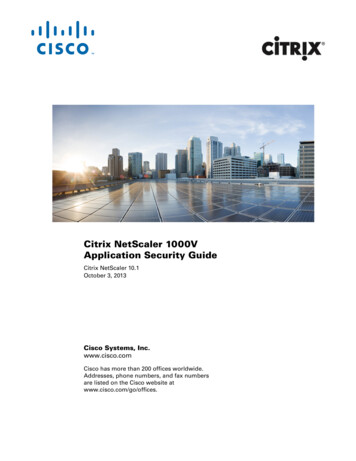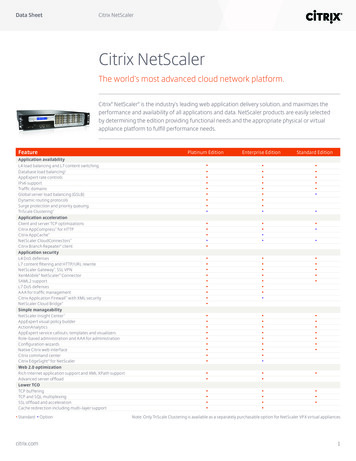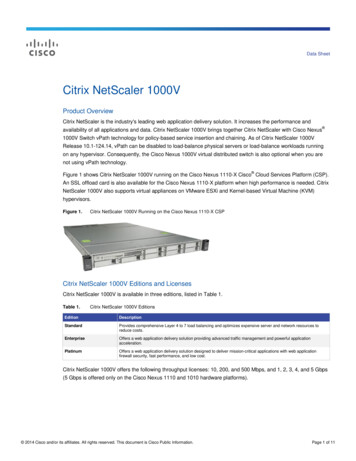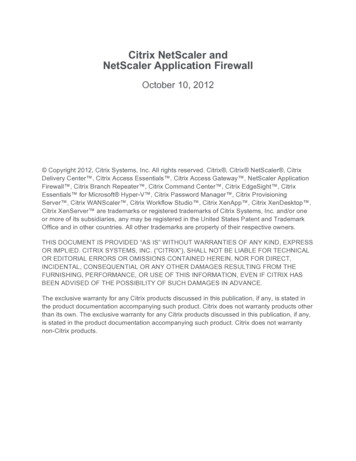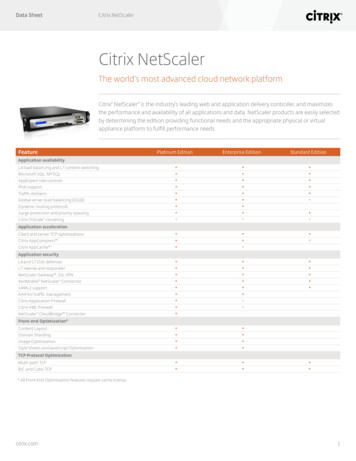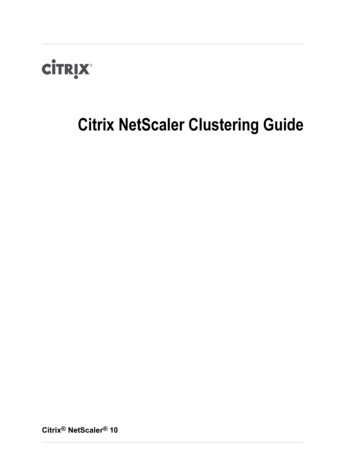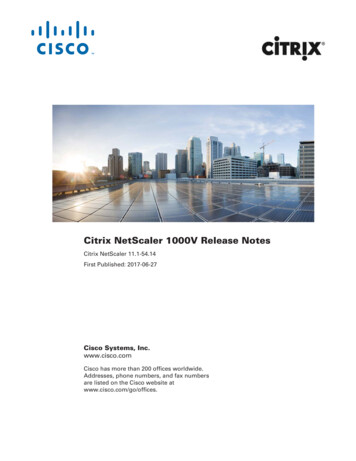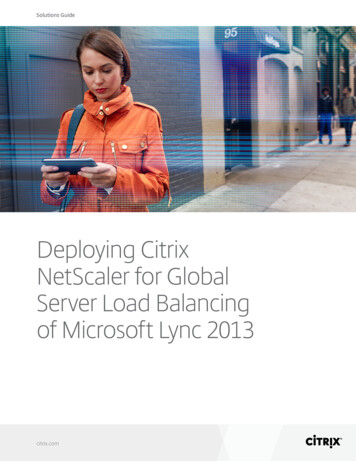
Transcription
Solutions GuideDeploying CitrixNetScaler for GlobalServer Load Balancingof Microsoft Lync 2013citrix.com
Solutions GuideTable of ContentsIntroductionOverview of Microsoft Lync 2013Why NetScaler GSLB Solution for Lync 2013?TopologyExternal ClientsDisaster SituationReverse Proxy Level OutageConfiguring the NetScaler GSLBProducts and version testedPrerequisites and configuration notesConfiguring NetScaler GSLBAdd SitesAdd ServicesAdding GSLB Virtual ServersConclusioncitrix.comDeploying Citrix NetScaler33344567777789102
Solutions GuideDeploying Citrix NetScalerCitrix NetScaler is the industry’s leading application deliverycontroller (ADC) and the best solution for providing global serverload balancing (GSLB) for Microsoft Lync, the enterprise-readyunified communication platform, to optimize and enhance itsperformance, availability and scalability. This guide will walk youthrough an easy-to-understand, step-by-step process fordeploying NetScaler with Lync 2013.This solution guide is an extension of the Deployment Guide for Microsoft Lync 2013 and Citrix NetScaler http://www.citrix.com/content/dam/citrix/en 3-and-citrix-netscaler-deployment-guide.pdf. Using this guide you will be ableto set up GSLB for Lync 2013 to ensure effective load balancing among multiple data centers andgain disaster recovery benefits.Overview of Microsoft Lync 2013Microsoft Lync 2013 is an enterprise-ready unified communication platform. It offers features suchas instant messaging (IM), voice over IP (VOIP), online conferencing, collaborative development, filesharing, integration with Exchange UM and federation services to integrate with other enterprises orpublic IM. Find complete information about the product at https://products.office.com/en-IN/lync/.Why NetScaler GSLB for Lync 2013?Lync 2013 enables employees of medium and large enterprises to conduct internal and externalcommunication securely from any device. Today many enterprises operate multiple data centers,which can be spread across the globe. The NetScaler GSLB module ensures continuous availabilityand recovery of applications such as Lync deployed at multiple data center locations. NetScalerGSLB balances the load across locations by directing client requests to the closest or bestperforming data center, or in the case of an outage, to other nearby data centers.The NetScaler GSLB feature enhances the availability, performance, usability and manageabilityof Lync 2013 by providing a high-availability proximity solution. This reduces the overall cost ofownership of Lync and helps improve business productivity.citrix.com3
Solutions GuideDeploying Citrix NetScalerTopologyExternal clientsThe GSLB deployment for Lync external clients will logically look like the one shown in Figure 1.Figure 1: External clients1. An external Lync user tries to log in. A DNS request for lyncdiscover.ctxns.net is issued.2. The request comes to the NetScaler GSLB virtual server to which this domain is bound.3. Upon receiving the request, the NetScaler GSLB virtual server resolves the domain name to thepublic IP address of the Lync reverse proxy at site 1 on the basis of some GSLB intelligence.4. The reverse proxy connects to the Lync Director server in this site and finds that the userinformation is available there. As in case of pool pairing, the SQL data is always in sync, so usersof one site can log in and use functionalities from any other site.5. The reverse proxy sends the IP address of the Lync Edge server at site 1.6. The user then connects to that Edge server and connects to the Director server of this site tovalidate itself.7. Then it connects to the Lync Front-End server for IM, presence information and other functionalities.citrix.com4
Solutions GuideDeploying Citrix NetScalerDisaster situationIn case of a site-level outage that makes site 1 unreachable, site 2 will be up as shown in Figure 2.Figure 2: Site-level outage1. An external Lync user belonging to site 1 tries to log into the Lync client. A DNS request forlyncdiscover.ctxns.net is issued.2. The request comes to the NetScaler GSLB virtual server at site 2, as it is the only active site.3. Upon receiving the request, the NetScaler GSLB virtual server resolves the domain name to thepublic IP address of the Lync reverse proxy at site 2.4. The reverse proxy connects to the Director server at site 2 and recognizes that the user belongsto the down site. This is possible because there is a pool pairing of the Director servers whichhelps identify the site to which the users belong. Even if the Director server is down in site 1, theuser information of site 1 is stored in the Director server of site 2.5. The reverse proxy sends the Edge server IP of site 2 as the Edge server at site 1 is unavailable.6. The user then connects to that Edge server and connects to the Director server of site 2 tovalidate himself.7. Then the user connects to the Front-end server for IM, presence information and otherfunctionalities. The Front-end servers also are in pool paring mode, which serves the users ofthe failed site completely.In this way, the GSLB solution ensures that if there is a data center-level outage, all the clients ofthat site will automatically connect to the active data center and the Lync application will remainfully available.citrix.com5
Solutions GuideDeploying Citrix NetScalerReverse proxy-level outageIn case of a reverse proxy-level outage, where the first point of connection goes down at one ofthe sites, the flow will be as shown in Figure 3.Figure 3: Reverse proxy-level outage1. An external Lync user belonging to site 1 tries to log in. A DNS request for lyncdiscover.ctxns.netis issued.2. The request comes to the NetScaler GSLB virtual server at site 2.3. Upon receiving the request, the NetScaler GSLB virtual server resolves the domain name to thepublic IP address of the Lync reverse proxy at site 2, as the reverse proxy at site 1 is not reachable.4. The reverse proxy connects to the Director server at site 2 and recognizes that the user belongsto site 1. This is possible because there is pool pairing of the Director servers, which helps identifythe site to which the user belongs.5. The reverse proxy sends the IP address of the Edge server at site 1, as the user belongs to site 1.Only the reverse proxy at site 1 is unavailable but the Edge server at that site is fully functional.6. The user then connects to that Edge server and connects to the Director server at site 1 tovalidate himself.7. Then the user connects to the Front-end server for IM, presence information and other functionalities.In this way, the GSLB solution ensures that if there is a component-level outage such as a reverseproxy failure, users can still connect to their site by leveraging the pool capabilities of the Lync servers.citrix.com6
Solutions GuideDeploying Citrix NetScalerConfiguring NetScaler GSLBProducts and version testedProductVersionsNetScaler systemNetScaler 10.5.52.5Microsoft LyncLync 2013Prerequisites and configuration notesThe following are general prerequisites and configuration notes for this guide: Lync servers are installed on all the sites and Lync topology is properly configured. Properconfiguration ensures that the Director servers and the Front-end servers are in a pool. The NetScaler load balancer, SSL and other configurations are made on all the sites. All the services are up and running.Configuring NetScaler GSLBStep 1: Create sites – local and remoteStep 2: Create services for the local virtual serversStep 3: Create virtual servers for the GSLB servicesStep 4: Bind GSLB services to the GSLB virtual serverStep 5: Bind domain name to the GSLB virtual serverAdd SitesGSLB SitesNameGive a unique name to the site(GSLB - Sites)TypeSelect whether the site will be local or remoteSite IP AddressAdd the site IP addressPublic IP AddressAdd the public IP address of this sitecitrix.com7
Solutions GuideDeploying Citrix NetScalerAll the sites in the topology are added in each NetScaler so that every site is in sync with the othersby MEP exchange. This enables each site to know about the health and traffic load of the others.Add ServicesGSLB ServicesService NameGive a unique name to the service(GSLB - Services)Site NameSelect the site to which this service belongTypeSelect if the service is IP based or name basedService TypeSelect the applicable protocolPortSelect the applicable portServer NameSelect the corresponding NetScaler LB virtualServer Namecitrix.comServer IPAdd the LB virtual server’s IP addressPublic IPAdd the public IP of the LB virtual serverPublic PortAdd the public port number of the LB virtual server8
Solutions GuideDeploying Citrix NetScalerThe load balancing virtual servers are added as GSLB services. Both local and remote virtual serversare added in all the GSLB sites.Adding GSLB virtual serversGSLB Virtual ServersNameGive a unique name to the virtual server(GSLB - Virtual Servers)DNS Record TypeSelect the applicable record typeService TypeSelect the applicable protocolMethodSelect the site-level load balancing methodBackup MethodAdd the applicable backup site-level load balancing methodBind appropriate GSLBservices and domain namescitrix.com9
Solutions GuideDeploying Citrix NetScalerGSLB virtual servers are added in each site and services are bound to them. Also, domain namesare bound to each virtual server.ConclusionCitrix NetScaler, a leading application delivery solution, is best suited to provide hardware-based loadbalancing and GSLB capabilities for Microsoft Lync 2013. Various features of NetScaler enables morethan simple load balancing of Lync servers located in one data center. The NetScaler GSLB featureenhances the availability, performance, usability and manageability of Lync 2013 by providing a highavailability proximity solution. This reduces the overall cost of ownership of Lync and helps improvebusiness productivity. To learn more about how NetScaler can bring these benefits to Lync installationsor address other application delivery requirements, please visit www.citrix.com.Corporate HeadquartersFort Lauderdale, FL, USAIndia Development CenterBangalore, IndiaLatin America HeadquartersCoral Gables, FL, USASilicon Valley HeadquartersSanta Clara, CA, USAOnline Division HeadquartersSanta Barbara, CA, USAUK Development CenterChalfont, United KingdomEMEA HeadquartersSchaffhausen, SwitzerlandPacific HeadquartersHong Kong, ChinaAbout CitrixCitrix (NASDAQ:CTXS) is a leader in mobile workspaces, providing virtualization, mobility management, networking and cloud services toenable new ways to work better. Citrix solutions power business mobility through secure, personal workspaces that provide people withinstant access to apps, desktops, data and communications on any device, over any network and cloud. This year Citrix is celebrating 25years of innovation, making IT simpler and people more productive. With annual revenue in 2013 of 2.9 billion, Citrix solutions are in useat more than 330,000 organizations and by over 100 million users globally. Learn more at www.citrix.com.Copyright 2014 Citrix Systems, Inc. All rights reserved. Citrix and NetScaler are trademarks of Citrix Systems, Inc. and/or one of itssubsidiaries, and may be registered in the U.S. and other countries. Other product and company names mentioned herein may betrademarks of their respective companies.1214/PDFcitrix.com10
t-guide.pdf. Using this guide you will be able to set up GSLB for Lync 2013 to ensure effective load balancing among multiple data centers and gain disaster recovery benefits. Overview of Microsoft Lync 2013 Microsoft Lync 2013 is an enterprise-ready unified communication platform.
